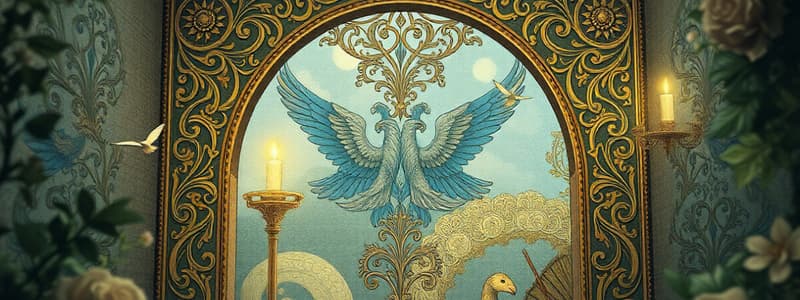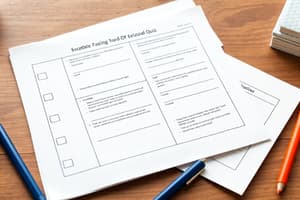Podcast
Questions and Answers
What materials did the Celts use to make their tools and weapons?
What materials did the Celts use to make their tools and weapons?
- Wood and glass
- Copper and silver
- Plastic and aluminum
- Iron and bronze (correct)
The Celts had a strong unifying leader similar to the Roman emperor.
The Celts had a strong unifying leader similar to the Roman emperor.
False (B)
What type of roof did Celtic tribes typically use for their huts?
What type of roof did Celtic tribes typically use for their huts?
Thatched roof
The time frame of the Hallstatt Period is from the ninth century BCE to the _____ century BCE.
The time frame of the Hallstatt Period is from the ninth century BCE to the _____ century BCE.
What was one of the primary goods traded by the Celts?
What was one of the primary goods traded by the Celts?
Name one artistic feature that characterized Celtic art during the La Tène Period.
Name one artistic feature that characterized Celtic art during the La Tène Period.
The value of _____ was important to the Celts for preserving food.
The value of _____ was important to the Celts for preserving food.
Match the periods with their respective time frames:
Match the periods with their respective time frames:
What primary materials did Celts commonly use for making their tools and weapons?
What primary materials did Celts commonly use for making their tools and weapons?
The Celts had a unifying leader, similar to the Roman Emperor.
The Celts had a unifying leader, similar to the Roman Emperor.
What was one valuable resource used by the Celts for food preservation?
What was one valuable resource used by the Celts for food preservation?
The Hallstatt Period lasted from the ninth century BCE to the fifth century BCE, during which the Celts engaged in trade with __________.
The Hallstatt Period lasted from the ninth century BCE to the fifth century BCE, during which the Celts engaged in trade with __________.
What characterized the art style of the La Tène Period?
What characterized the art style of the La Tène Period?
Celts manufactured their own clothing and textiles during ancient times.
Celts manufactured their own clothing and textiles during ancient times.
Match the Celtic periods with their characteristics:
Match the Celtic periods with their characteristics:
Celtic tribes constructed homes in the shape of __________ huts with thatched roofs.
Celtic tribes constructed homes in the shape of __________ huts with thatched roofs.
What material was found in the chieftain's burial site that indicates trade with distant cultures?
What material was found in the chieftain's burial site that indicates trade with distant cultures?
Name one commonality shared by the various Celtic tribes.
Name one commonality shared by the various Celtic tribes.
The ancient salt mines discovered near the chieftain's burial site provided evidence of the Celts trading ____ for silk.
The ancient salt mines discovered near the chieftain's burial site provided evidence of the Celts trading ____ for silk.
Which period includes clues about the Celtic lifestyle from the ninth century BCE to the fifth century BCE?
Which period includes clues about the Celtic lifestyle from the ninth century BCE to the fifth century BCE?
Match the following Celt-related items with their descriptions:
Match the following Celt-related items with their descriptions:
What term is used to describe the many distinct groups of people collectively referred to as Celts?
What term is used to describe the many distinct groups of people collectively referred to as Celts?
What was the significant role of trade in ancient Celtic society?
What was the significant role of trade in ancient Celtic society?
Flashcards
Celt groups
Celt groups
Diverse groups of people with shared heritage, but distinct differences in ways of life.
Hallstatt Period
Hallstatt Period
A period in early Celtic history, from 9th to 5th century BCE, marked by trade, including that with China.
La Tène Period
La Tène Period
A period in early Celtic history, from 5th to 1st century BCE, noted for Celtic spread in Europe and distinct art styles.
Celtic Trade
Celtic Trade
Signup and view all the flashcards
Celtic Art
Celtic Art
Signup and view all the flashcards
Celtic Settlements
Celtic Settlements
Signup and view all the flashcards
Celtic skills
Celtic skills
Signup and view all the flashcards
No Unifying Leader
No Unifying Leader
Signup and view all the flashcards
Roman and Greek views of Celts
Roman and Greek views of Celts
Signup and view all the flashcards
Archaeology's role in understanding Celts
Archaeology's role in understanding Celts
Signup and view all the flashcards
Meaning of "Celt"
Meaning of "Celt"
Signup and view all the flashcards
What united Celtic tribes?
What united Celtic tribes?
Signup and view all the flashcards
Celtic trade during Hallstatt Period
Celtic trade during Hallstatt Period
Signup and view all the flashcards
Celtic skills beyond trade
Celtic skills beyond trade
Signup and view all the flashcards
Celtic Identity
Celtic Identity
Signup and view all the flashcards
Celtic Dwellings
Celtic Dwellings
Signup and view all the flashcards
What did the Celts have in common?
What did the Celts have in common?
Signup and view all the flashcards
Who were the Celts?
Who were the Celts?
Signup and view all the flashcards
What did the Celts share?
What did the Celts share?
Signup and view all the flashcards
What is a living fossil?
What is a living fossil?
Signup and view all the flashcards
What is a notochord?
What is a notochord?
Signup and view all the flashcards
What are lobe fins?
What are lobe fins?
Signup and view all the flashcards
What is a rostral organ?
What is a rostral organ?
Signup and view all the flashcards
Why is the name 'Celt' used?
Why is the name 'Celt' used?
Signup and view all the flashcards
Why are archaeologists important?
Why are archaeologists important?
Signup and view all the flashcards
What is the Hallstatt Period?
What is the Hallstatt Period?
Signup and view all the flashcards
How were Celts described by Romans and Greeks?
How were Celts described by Romans and Greeks?
Signup and view all the flashcards
Why is the La Tène Period significant?
Why is the La Tène Period significant?
Signup and view all the flashcards
What is the importance of the Ronan-Celtic Period?
What is the importance of the Ronan-Celtic Period?
Signup and view all the flashcards
What are some features of Celtic settlements?
What are some features of Celtic settlements?
Signup and view all the flashcards
How has Jim's experience changed?
How has Jim's experience changed?
Signup and view all the flashcards
How does Jim react to lassoing Father Time?
How does Jim react to lassoing Father Time?
Signup and view all the flashcards
What does Father Time tell Jim?
What does Father Time tell Jim?
Signup and view all the flashcards
What does Father Time mean by 'invisible'?
What does Father Time mean by 'invisible'?
Signup and view all the flashcards
Why is Father Time angry?
Why is Father Time angry?
Signup and view all the flashcards
What is Jim's attitude towards Father Time?
What is Jim's attitude towards Father Time?
Signup and view all the flashcards
What happens when Jim lassoes Father Time?
What happens when Jim lassoes Father Time?
Signup and view all the flashcards
Where does Father Time need to be?
Where does Father Time need to be?
Signup and view all the flashcards
How does the author develop the relationship between Jim and Father Time?
How does the author develop the relationship between Jim and Father Time?
Signup and view all the flashcards
What is Jim's final action regarding Father Time?
What is Jim's final action regarding Father Time?
Signup and view all the flashcards
What does the author accomplish by including details about the coelacanth's features?
What does the author accomplish by including details about the coelacanth's features?
Signup and view all the flashcards
How is the author organized?
How is the author organized?
Signup and view all the flashcards
How does the author use evidence for the Central Idea?
How does the author use evidence for the Central Idea?
Signup and view all the flashcards
Why is the coelacanth endangered?
Why is the coelacanth endangered?
Signup and view all the flashcards
Why is it difficult to observe coelacanths?
Why is it difficult to observe coelacanths?
Signup and view all the flashcards
Why is the coelacanth considered a living fossil?
Why is the coelacanth considered a living fossil?
Signup and view all the flashcards
What is the most likely reason the author used dialogue?
What is the most likely reason the author used dialogue?
Signup and view all the flashcards
Study Notes
No Topic Provided
- Insufficient information provided to create study notes. Please provide the text or questions.
Studying That Suits You
Use AI to generate personalized quizzes and flashcards to suit your learning preferences.




